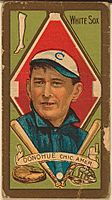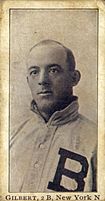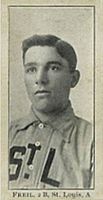Triple play facts for kids
Jiggs Donahue, Billy Gilbert, and Bill Friel (left to right) of the Milwaukee Brewers recorded the first triple play in American League history on July 14, 1901, against the Chicago White Stockings.
In baseball, a triple play (denoted as TP in baseball statistics) is the rare act of making three outs during the same continuous play.
Triple plays happen infrequently – there have been 722 triple plays in Major League Baseball (MLB) since 1876, an average of approximately five per season – because they depend on a combination of two elements, which are themselves uncommon:
- First, there must be at least two baserunners, and no outs. From analysis of all MLB games 2011–2013, only 1.51% of at bats occur in such a scenario. By comparison, 27.06% of at bats occur with at least one baserunner and fewer than two outs, the scenario where a double play is possible.
- Second, activity must occur during the play that enables the defense to make three outs. Common events – such as the batter striking out, or hitting a fly ball – do not normally provide opportunity for a triple play. A ball hit sharply and directly to an infielder, who then takes very quick action – or unusual action, confusion, or mistakes by the baserunners – is usually needed.
In baseball scorekeeping, the abbreviation GITP can be used if the batter grounded into a triple play.
See also
 In Spanish: Tripleplay para niños
In Spanish: Tripleplay para niños

All content from Kiddle encyclopedia articles (including the article images and facts) can be freely used under Attribution-ShareAlike license, unless stated otherwise. Cite this article:
Triple play Facts for Kids. Kiddle Encyclopedia.



